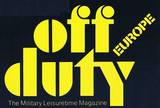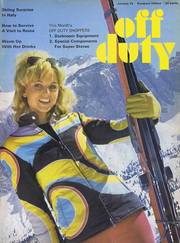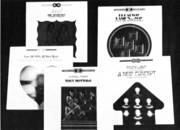"off duty" 1970 - 1997 - eine Freizeit-Zeitung für's US-Militär
Die in diesem amerikanischen (Freizeit-) Shopping-Magazin angepriesenen Hifi- und Video-Produkte waren auschließlich amerikanischen und kanadischen Militärangehörigen zugänglich - also zu kaufen - und vor allem zu ganz ungewöhnlich (verblüffend) niedrigen US $ Military-Preisen. Zu der einführenden "off duty" Seite geht es hier lang. - Um 1970 begann der weltweite Hifi-Boom bis zum 1. Crash 1978 und dann wieder zum 2.Crash um 1990. Über die 20 Jahre nach 2001 lesen Sie mehr in den Kolumnen auf diesen japanischen Seiten.
.
off-duty / Europe / Januar 1972
Software for 4-Channel Hardware
Real surround sound LPs ready to go to market
vom Herausgeber - By WALTER B. RIOS - im Januar 1972
.
MOST OF THE FUSS .......
MOST OF THE FUSS, when discussing 4-channel systems in these pages the last few months, has been over hardware - the equipment you need for surround sound, and whether to go all the way with four "discrete" signals or settle for some kind of matrix system.
While touting their systems, meanwhile, manufacturers of 4-channel hardware know deep down inside that what's going to settle the controversy is what they call "software" - the records and tapes you play on your equipment.
And the race is on.
The maker who shows up with the mostest stands the bestest chance of winning. And the race is on.
As each system is introduced, usually in the form of a "paper" presented to a cynical, all-questioning panel of broadcast and recording engineers demanding to be shown, there are behind the scenes huddles between the designers and the marketing moguls who make the key decisions whether to take a commercial plunge on something new and untried.
"Will it work?," the question the engineers can answer, is strictly for openers. "Will it sell?" is the big one. And the cruncher is, "Will it sell better than my competitor's system?"
What's going on right now ?
And that's what 4-channel is going through right now. Each system has a handful of experimental records to its credit, usually arranged with a small independent lables such as Vanguard Records. Out from the vault comes some suitable 4-channel material, such as the much-used Berlioz Requiem or an album of Joan Baez favorites.
It's simply re-mastered according to the new system. A few hundred pressings will find their way to critics, broadcasters and the technical press, compliments of the manufacturer touting the system.
But little of this material has, thus far, trickled down to the Stateside record store level, much less the PX level, where the selection of LPs is determined largely by scrutinizing the Billboard charts. So the military 4-channel buff, the first-in-the-billets with surround sonics (equipment-wise, that is), finds himself on the short end when looking for the real stuff to play.
.
Where are the 4-channel records ?
Happily, he won't have to wait much longer. Not that he'll find a sunny 4-channel bonanza at his friendly PX next week.
But the sky's brightening. We have at hand a few matrixed quadraphonic discs that are ready for market, with the jackets printed and loaded with basic data on what quadraphonic sound is all about.
And, more important, with LPs inside that do the job. They show off the glory of surround sound far better than the "phony 4-channel" you get with some conventional stereo LPs played through matrix decoder.
Some rare Stereo LPs will suprise ...
True, some LPs already in your library will surprise you now and then, delivering unexpected rear-channel information when played through a quad set-up, but nothing like the real thing.
A record engineered for surround sound, with a matrix encoder, can put as much information in the rear channel as the engineer dictates.
You'd be hard-pressed to tell the difference between a matrixed and a discrete 4-channel version of the same recording, even in careful listening to an A'B test pitting the "pure" 4-4-4 against a 4-2-4 copy (I've listened and listened, and been fooled many a time).
Echtes 4-channel machen nur die Toningenieure
The key to what you'll hear in the rear channels, as I mentioned, is in the hands of the engineer.
And it's evident from the quadraphonic recordings I've auditioned so far that good taste will prove to be a strong factor.
There's a limit to how much rattling you should hear in the rear channels in most recordings. Much depends on the type of music.
The handful of ABC records I've sampled covers quite a bit of ground, and the 4-channel effect varies accordingly.
It's fitting that the first entry is dubbed Persuasive Percussion, conjuring up memories of the sonic spectaculars that ushered in the stereo LP era more than a decade ago.
The well known ping-pong effects
Sure enough, there are ping-pong effects in this Command Quadraphonic disc (CQD 40000), with bongos, bass and brushes bouncing from left to right, front and rear.
The jacket liner makes no apologies for the gimmicks, urging the listener to use the release as a test record. It does, indeed, offer a chance to check levels all around, something much harder to do with matrixed recordings that use the rear channels only for hall ambiance.
So Persuasive Percussion serves a useful purpose, and instead of the sine waves and tone bursts a test record would provide, this one has some easy listening, its gimmicked sound lavished on arrangements of "My Heart Belongs to Daddy," 'The Breeze and I," "I'm in the Mood for Love," "Love is a Many Splendored Thing" and others.
Es gibt eine zweite Platte
Even easier listening comes with the second disc. Guitar...Paris by Tony Mottola (CQD 40001). Much less bouncing from speaker to speaker, but a superb spread of sound anywhere in the room.
While the engineers will presumably learn a great deal as they continue to sharpen their new 4-channel tools, it's evident they've already figured out that sitting in the middle of the band stand can be a bit distracting, 4-channel or no 4-channel.
Blending some of the bass into both the right-front and right-rear channels moves the player over to about 3 o'clock, so he isn't slapping the instrument in your ear.
Enoch Light and the Mottola disc
The Mottola disc, produced by sonic innovator Enoch Light, has a French flavor ("C'est si bon," "Under Paris Skies," "La Vie en Rose" etc.). Well engineered and fine listening.
Two more ABCs in the new series, Fever, by Doc Severinsen and his trumpet (CQD 40003) and Broadway... Basie's Way by Count Basie and Orchestra (CQD 40004) give some idea what 4-channel does with the sound of a big band.
For material the artists again fall back on standards and showtunes. The sonics are imposing, with the rear channels used more to achieve fullness than gimmicky effects.
The 4-channel classical releases
The first classical release by ABC is "Welcome to Vienna", with soprano Beverly Sills displaying her trills and pianissimos in Johann Strauss and Franz Lehar favorites, and Julius Rudel leading the London Philharmonic Orchestra.
Here's a case where 4-channel is used to project plenty of hall ambiance - it's an open, highly resonant sound such as you might hear sitting in the rear of a large, crowded and very live concert hall.
All that's missing is the applause after each number to give the recording extraordinary you-are-there presence.
Und jetzt wird beschwichtigt - Quadro auf Stereo- Playern
All these 4-channel discs can, of course, be played on conventional stereo equipment, without any of the music lost.
Curiously, the Sills-Rude! concert doesn't come off as well sonically in regular stereo. So much of the ambiance effect is actually in the front channels that, without the rear speakers, the echo sounds overdone.
.
- Anmerkung : Das stimmt so nicht, es sind bei hochwertigen Stereo- Abtastern deutliche Unterschiede in der Hifi-Qualität einer echten Stereoaufnahme mit dem Stereo-Abtaster im Vergleich mit dem 4-Kanal- Äquvalent mit dem gleichen Stereo-Abtaster zu hören. Man braucht dazu aber beide Platten auf dem gleichen Laufwerk und der gleichen Stereo Anlage.
.
But as we play the sparkling overture to "A Night in Venice" and hear Beverly Sills launch into "Vienna, City of My Dreams," we have audible proof that 4-channel really adds something worthwhile to the listening experience.
Also machen wir mal gutes Wetter für zukünftigen Umsatz
The new recordings mentioned are all encoded according to the Sansui QS system and can be played back in 4-channel through any of the compatible matrixes built into equipment by Pioneer, Kenwood and National-Panasonic, as well as Sansui's own QS.
The discs are also compatible with the Electro-Voice and Dyna matrix systems in the U.S., and with the matrix in Fisher's 601 4-channel receiver. According to most engineers, the method of phase-shrift used in the CBS/Sony SQ matrix makes it incompatible with these records - but rumors persist that the differences will soon be sorted out.
Word as to when the new discs will arrive overseas is expected shortly. If you'd like more information as to where to get them, write "4-channel" in the space reserved for Special Request on the Reader Information card in this issue of OFF DUTY, and mail in the card promptly.
.
vom Herausgeber - By WALTER B. RIOS - im Januar 1972
.
- Anmerkung : Es gab ja mehrere Gründe, warum die Tonmeister bei der DGG und bei Polydor und auch bei den kleineren Labels hier bei uns so zögerlich mit der ganzen Quadro-Technik waren. Sie hatten die Theorie und Spezifikationen der Japaner über SQ und QS schon gelesen und zwischen den Zeilen den Unsinn mit der Phasenverschiebung innerhalb der Hauptinformation der beiden Stereokanäle bei SQ und QS "gerochen".
.





